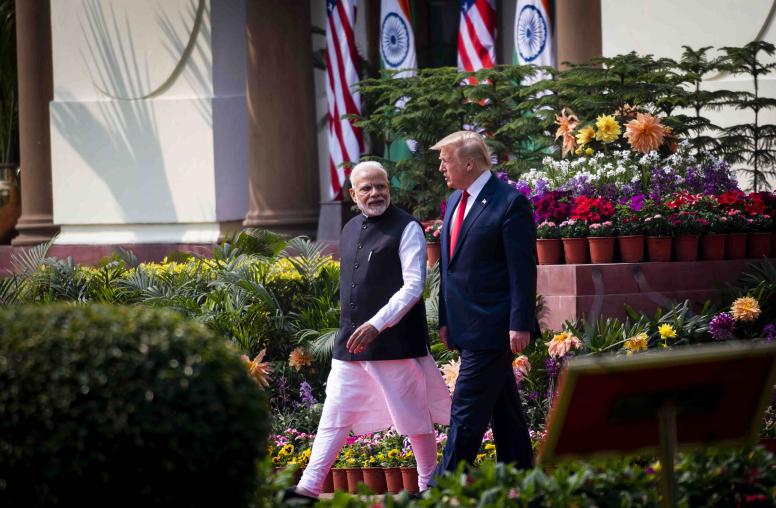India’s Nobel Winner Takes His Fight for Children Global
Peace Prize Laureate Satyarthi Outlines Campaign at USIP
Indian children’s rights campaigner Kailash Satyarthi is using his Nobel Peace Prize to build a global campaign to end child labor and enslavement. He outlined his plan at the U.S. Institute of Peace last week in his first visit to the U.S. since receiving the award.

“I am planning to launch the world’s most ambitious … mobilization of young people for the betterment of the whole world,” Satyarthi told USIP staff members June 17. “I’m aiming at 100 million young people … [who] should become the voices, faces, spokespersons, advocates, change-makers, leaders, champions” for 168 million children worldwide who are trapped in child labor, half of them as slaves, child soldiers, prostitutes, or in highly dangerous jobs, he said.
Satyarthi received the Nobel Peace Prize in December alongside the Pakistani activist for girls’ education, Malala Yousafzai. He is using his new celebrity to expand on his work in India, where his Save the Childhood Movement (the Bachpan Bachao Andolan) counts nearly 85,000 children that it has rescued from slavery or other bonded labor since 1980. He recently opened a U.S.-based foundation to help jump-start his new mission.
Sen. Tom Harkin Joins
For his new Kailash Satyarthi Children’s Foundation, Satyarthi recruited an old friend from the U.S. Congress, former Senator Tom Harkin, as one of three Washingtonians to serve on the board . Harkin, who retired from his Iowa Senate seat in January, began supporting Satyarthi’s work in the 1990s, and was one of those who formally nominated Satyarthi for the Nobel Prize. Harkin backed numerous children’s rights bills during his 40 years in Congress.
“When millions of children are living in slavery and [are] sold and bought like animals, we cannot think of a sustainable peace and development.” – Kailash Satyarthi, Nobel Peace Prize laureate
Other founding board members of the Satyarthi Foundation are Washington entrepreneur and attorney Connie Milstein and human rights advocate Kerry Kennedy, who also serves on the board of directors of USIP.
Satyarthi’s trip to the United States coincided with a visit by Yousafzai. The two campaigners met for the first time at December’s Nobel Peace Prize ceremony, “and they hit it off personally,” said Anjali Kochar, a Washington-based Indian-American who helped Satyarthi organize his visit. “They are keeping in touch as they continue their work,” Kochar said.
Last week, Satyarthi, 61, hustled from meeting to meeting—at USIP, on Capitol Hill, and in New York City, wearing his white, traditional Indian kurta. On June 16, his new foundation held a small rally near USIP at the Lincoln Memorial on the anniversary of the 1858 anti-slavery speech in Illinois that helped propel Abraham Lincoln to the White House two years later.
Millions of Children Enslaved
At USIP, Satyarthi sought advice from several Washington-area interfaith leaders on how best to mobilize religious communities on children’s rights issues. The discussion included the Rev. Gary Hall, dean of the Washington National Cathedral; Sister Simone Campbell, the executive director of Network, a Roman Catholic lobby on social justice issues; the State Department’s special representative for religion and global affairs, Shaun Casey; and Imam Mohamed Magid, the Northern Virginia cleric who is president of the Islamic Society of North America.
Speaking later to USIP’s staff, he underscored that building peace in the world depends on improving justice and development opportunities for billions of people worldwide who cannot find either.
“When millions of children are living in slavery and [are] sold and bought like animals, we cannot think of a sustainable peace and development,” Satyarthi said. “One hundred and sixty eight million children in the world are trapped into various forms of child labor; 85 million of them are working as slaves, as domestic workers, as child soldiers, as child prostitutes, and also in mines and factories under extremely hazardous conditions. Five and a half million children are still in slavery,” he said, a crime statistic that the world has not managed even to reduce over the past 15 or more years, according to U.N. data.
And it’s not that we haven’t identified the problem, Satyarthi said: “We have the Universal Declaration of Human Rights, we have the United Nations Convention on the Rights of the Child, and we have so many safeguards. … But 160 million children suffer malnutrition; 15 million girls were married last year as child brides.”
Satyarthi noted that the U.N. is now finalizing a set of global development goals for the next 15 years, to be approved in September by the world’s heads of state at the U.N. General Assembly. These “Sustainable Development Goals” should be based on “what I call the four P’s,” Satyarthi said—people, planet, prosperity and peace. “They should be interwoven; they are not four different compartmentalized things,” he added.
Satyarthi urged a greater focus in international development on preserving the planet’s ecosystem from the effects of global warming and pollution. He urged a broadening of human prosperity, lamenting the finding, in a recent study by Oxfam International, that the richest 1 percent of people will by next year own 50 percent of the world’s wealth.
James Rupert is a senior writer and editor at the U.S. Institute of Peace.



